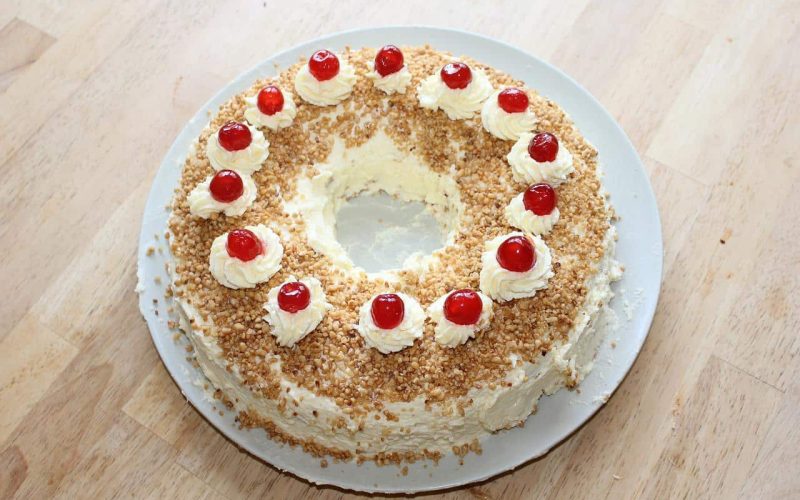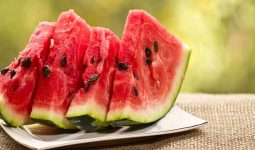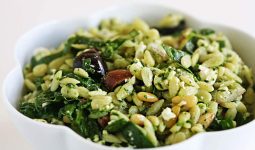When the weather starts to cool down and fall officially begins, you’ll soon be able to enjoy some of the most famous traditional German desserts, which have stood the test of time.
However, Germany has had all kinds of delicious treats in its history, from creamy desserts made with fresh cream to pastries and pieces of bread perfect for dunking in tea.
When you look at these desserts, you’ll see how German culinary traditions have influenced modern cuisine worldwide.
Therefore, these are the best traditional German desserts to try this fall.
Apple strudel
An apple strudel’s warm, buttery dough can make even a cloudy fall day feel like summer.
The recipe traditionally calls for flour, sugar, eggs, and apples, but you may prefer peaches, pears, or cherries.
Whichever fruit you choose will pair nicely with a vanilla sauce (vanilla and cinnamon are often used in traditional recipes).
But if you want to get creative, opt for something bolder. Perhaps chocolate or caramel sauce?
However, you could even use maple syrup for something original and delicious. The possibilities are endless.
Ensure your filling is chopped into small pieces before rolling up your dough.
Because it’ll be tricky to dice them once they’re baked into a strudel.
Black forest cake
Created in Germany in 1874, black forest cake is an iconic dessert in Germany and much of Europe.
Its dark chocolate base, covered with whipped cream and cherries, makes it an excellent option for those looking for a less sugary treat.
However, it’s a bit dense but can be refreshing if you eat it on a warm day.
A popular option among tourists and locals, black forest cake can be found everywhere around Europe.
But do yourself a favor and seek out some authentic opportunities.
Käsespätzle (cheese spaetzle)
Cheese spaetzles is one of the best traditional German dessert dishes in Baden-Württemberg, Germany.
It’s served as a side dish with meat dishes, such as roast pork, sausage, and sauerkraut.
The soft noodles are made from egg noodles and are usually topped with a thin cheese sauce.
However, you can also top it with applesauce, sour cream, or both. The best way to make cheese spaetzle is by using ricotta cheese.
Regarding other cheeses, you can either use a mild type of Gouda or add Parmesan. Into your recipe if you like it extra cheesy.
Topfenpalatschinken (cottage cheese pancakes)
In Munich, try these beloved pancakes made from creamy open cheese and served with fruit toppings. Many say they taste like crepes.
While Topfenpalatschinken is often eaten as a breakfast dish in Germany, visitors can also enjoy them at dinner in many restaurants.
However, they’re typically smaller than crepes (about eight inches wide) but thicker and less delicate.
The pancakes go well with stewed apples or plums topped with powdered sugar, cinnamon, or mixed berries.
Linzer torte
A Linzer torte is made with almond or hazelnut shortbread and raspberry jam in its most basic form.
As you can imagine, with so few ingredients, each must be top-notch. Smelling them is an excellent way to tell if your ingredients are fresh.
Anise from aniseed and citrus from lemon zest should smell quite strong when smelled alone.
If your ingredients don’t smell like much (i.e., if anyone’s even willing to eat your shortbread), then there’s a good chance they aren’t very fresh either.
Zwetschgenkuchen (plum cake)
A cake layered with cherries, cream, and chocolate is served in a long rectangular dish.
It’s said that each layer of a Schwarzwälder Kirschtorte has a different flavor.
The bottom layer is chocolate, followed by sour cherry and vanilla custard.
Moreover, the cake is traditionally eaten on December 6th every year. It originated in southern Germany (Bavaria), but today it’s famous all over Germany and other European countries.
Schwarzwälder Kirschtorte (Black Forest cake)
Schwarzwälder Kirschtorte is a semi-firm, dark chocolate cake that combines many flavors in one exquisite package.
It is rich and dense and contains kirschwasser (cherry brandy) and cream-filled layers.
Before baking, it is coated with a crumb mixture that includes sliced almonds, cocoa powder, and confectioner’s sugar.
Therefore, it looks like it’d be heavy, but it isn’t; instead, because of its density, it is smooth and creamy.
German Plum Dumplings (Zwetschgenknoedel)
Zwetschgenknoedel, or plum dumplings, are traditional German desserts popularized in Bavaria and other southern regions of Germany.
These delicious treats are made from plums poached with sugar and vanilla and then pressed through a sieve.
However, the pulp is mixed with eggs, flour, and nutmeg before forming small balls.
These dumplings are boiled for about 15 minutes before being eaten warm with butter or vanilla sauce.
Blushing Maid dessert
Blushing Maid is a gorgeous creation that uses tart cherries and a delicious, creamy topping for a show-stopping treat.
These traditional German desserts taste just as good as they look. You won’t want to skip it at your next dinner party.
Nevertheless, the cherry pie filling can be made ahead of time. So you have to make sure everything is excellent and cold before serving.
Bienenstich (Bee Sting Cake)
Bienenstich is a delicious layered cake often enjoyed for breakfast or snacks.
It’s a popular treat in Germany, especially during the Advent season, when street vendors, cafes, and bakeries all over the country offer it.
We love serving it with coffee or tea after dinner. The marzipan layer on each slice adds a little crunch and sweetness.
Rote Grütze (Red Berry “Pudding”)
Rote Grütze is a traditional German dessert made of berries, sugar, and occasionally cinnamon.
It’s a winter fruit pudding often served at festivals and feasts like Christmas, Easter, and weddings. You can even find it in Germany during Oktoberfest.
Fortunately, the rich consistency is somewhat similar to American puddings but with a tangy, tart flavor from all those berries. My favorite way to enjoy rote grütze is with vanilla ice cream.
It’s also great on toast, smoothies, or even eaten cold out of a bowl.
German Chocolate Bars
Picking up a traditional German dessert chocolate bar while traveling abroad is a treat any time of year.
Still, if you visit Germany during the fall, you can try authentic versions of these delectable treats at home.
As autumn brings shorter days and cooler temperatures, eating sweets will keep your belly warm on chilly nights out.
However, the bars are also an excellent way to get into the winter spirit.
Most feature marzipan and coconut, elements of popular Christmas confections that are brought out again once December rolls around.
Therefore, read about some of Germany’s best options for seasonally inspired chocolates. And don’t forget to bring a few home with you after your visit.
Strawberry Rhubarb Trifle
Please look at your local farmers ‘ market before you run out and buy a bushel of strawberries.
There’s a good chance they have an abundance of them right now. Pair them with another bountiful summer fruit: rhubarb.
However, rhubarb’s tart flavor is perfect for removing some sweetness from fresh strawberries, which can get cloying quickly when paired together.
The tangy-sweet strawberry-rhubarb combination in traditional German desserts like strawberry pie or shortcake screams summer.
So it’s only natural that it makes for great fall conventional German desserts.
Sweet Venison Cake
Venison is not only a taste of traditional German desserts but of other European countries as well.
If you haven’t tried it before and are a meat-eater, you may want to try some venison.
You can prepare venison to make it more palatable and less gamey tasting.
Therefore, one way is to combine it with other things, such as cranberries or blueberries.
When harvested, cranberries still have some of their natural acidity intact, making them rather tart.
So they combine very well with sweet traditional German desserts like cake.
German Fruit Flan
Perhaps one of Germany’s most popular desserts is flan. It is a caramel-like pudding made from eggs, sugar, and sweetened milk. The consistency is rich and creamy; flan can come in various flavors.
However, you’ll often find European fruits used as a flavoring for flan. And because fresh fruit is usually incorporated into homemade recipes, you get an added nutritional boost.
The classic flan recipe calls for vanilla, but feel free to experiment with other flavors like almond extract or citrus.
Therefore, if your mouth isn’t watering, wait until you see how it looks plated up. Your guests will think you put in extra effort even if you didn’t!
German Coconut Macaroons
Made with whipped egg whites, coconut, and shredded coconut. Macaroons are a delicious, simple dessert that can be served as part of a more extensive spread.
More so, these coconut macaroons include almonds for extra crunch and flavor. We love them topped with chocolate syrup.
German Rum Balls
Rum balls are great traditional German desserts that are simple and delicious.
They contain nothing more than ground almonds, icing sugar, cocoa powder, a dash of rum extract, and a small handful of chocolate chips.
Therefore, the mixture can be rolled into little balls or pressed into chocolate molds.
They are usually served alongside other sweet treats such as cakes, desserts, or ice cream. It’s best when enjoyed just after making them.
German Rum Balls
Rum balls are one of the best traditional German desserts. They are super easy (and delicious) treats to make.
They’re popular all year round in Germany but delicious in cooler weather.
Roll them in powdered sugar or cocoa powder, or enjoy them as is.
Therefore, make a batch for your next bake sale and watch them fly off your table. Here’s our recipe for rum balls. Enjoy.
Spaghetti Ice Cream
According to two different sources, the Germans invented spaghetti ice cream. Many assume it was a joke or a hoax, but there are multiple recipes for Spaghetti Ice Cream dating back to 1917.
Moreover, the most fantastic recipe dates back to 1932. It comes from Die Neue Küche: Ein Kochbuch für Jeden Tag(or The New Kitchen: A Cookbook for Every Day).
It’s believed that World War II led Italians to live in Germany back home.
In addition to taking their spaghetti ice cream recipes with them. But if you’re not up for making it yourself.
Aldi is now selling a frozen version of spaghetti ice cream that you can enjoy at home.
Dipped Gingersnaps
Nothing beats a bowl of warm gingersnap cookies on a fantastic fall day.
But you can take your gingerbread experience up a notch by dunking them in cinnamon-infused hot chocolate—the perfect combination of spicy and sweet.
However, these classic German desserts are so good that they’ll quickly become your favorite fall treat.
So, gather your ingredients and get ready to indulge in one of Germany’s most extraordinary culinary gifts.
Linzer Cookies
I was five years old the first time I tried these delectable treats. We celebrated with my paternal grandmother, who had made them for us. It was love at first bite.
However, these sweet bites will win over any holiday gathering or summer BBQ.
Sunday morning coffee break made with basic cookie dough and topped with raspberry jam and powdered sugar.
Plus, they are pretty simple to make (though you’ll need a bit of patience).
Therefore, start by making a batch of dough and letting it chill in your fridge while you prepare your fruit. This will ensure uniform cookies that bake evenly.
Roll out your chilled dough into two equally sized rectangles. Cut each rectangle into six equally sized squares (like a pizza) before filling.
German Crumb Cake
For traditional German desserts, serve a slice of crumb cake with a glass of cold milk and whipped cream.
Crumb cake is straightforward to make, too: stir all of your ingredients together in one bowl, pour into a greased cake pan, and bake.
Therefore, top with whipped cream or ice cream, and enjoy. If you prefer chocolate crumbs over cinnamon-spiced ones, use Hershey’s cocoa powder instead.
You can also change your fruit: If desired, you can use apples or pears in place of cranberries.
Finally, remember that a minimal amount of nutmeg goes a long way. Add more sparingly if you want less flavor.
Authentic German Lebkuchen Recipe
Traditionally, these spiced gingerbread cookies are cut into heart shapes.
Use authentic ingredients to create your delicious lebkuchen recipe, a treat that everyone will love.
Lebkuchen can be stored in an airtight container at room temperature for two weeks. Store them longer than that, and they may start losing their flavor.
Like most baked goods, lebkuchen tastes even better when fresh from the oven. While you can buy all sorts of commercial lebkuchen mixes and kits,
Sometimes, making your homemade version using traditional ingredients like honey or almond extract is more fun and affordable.
German Rice Pudding
It’s rare to find a dessert that makes a great breakfast food, but it’s valid with rice pudding.
Rice pudding is packed with carbohydrates and has been associated with breakfast for a long time.
It is made by boiling whole-grain rice in water until it becomes thick and stirring in sugar, vanilla extract, and raisins.
However, it’s simple enough for kids (and adults) to whip up. It can be served warm or cold, depending on your preference.
Peppernut Cookies (Pfeffernusse)
Invented in Berlin, these spicy and chewy little morsels can be made with various nuts, though pecans and walnuts are the most popular.
The most traditional variety is peppered with cayenne pepper (hence peppernut), hence their name.
Pfeffernusse don’t keep very well, so eat them within a few days. Gingerbread: These tasty treats were initially designed for Christmas but are now enjoyed all year round in Germany and beyond.
Traditionally made with dark rye flour, honey, or brown sugar, gingerbread cookies are meant to be eaten after dinner.
Cinnamon Star Cookies
These cookies come from an old Transylvanian recipe. What makes them different from any other Christmas cookie is their star shape and the cinnamon they contain, which spices things up.
They are commonly enjoyed in Germany with hot coffee or tea on Christmas Eve.
Since many people in Romania don’t celebrate Christmas, these cookies are just as standard on New Year’s Eve. Enjoy them either way.
Sacher Torte
This Austrian chocolate cake has layers of apricot jam and bittersweet chocolate.
Which can be served as a decadent dessert or, in more modest portions, as a decadent after-dinner treat.
Interestingly, Franz Sacher, who worked at Hotel Sacher in Vienna, invented the Sacher Torte.
However, the Hotel was founded by Eduard and Katharina Sacher, who named it after themselves, Hotel Sacher.
One day in 1832, Franz decided to make a chocolate cake for afternoon tea.
He used flour from his father’s mill instead of bread flour and replaced some with ground hazelnuts.
Apple Strudel
You won’t find apple strudel in many restaurants because it takes time and effort to prepare. However, the topping is thin and crispy, making it worth preparing at home.
But what makes it truly special is that layer of soft apples between crisp pastry. Cook your apples just until they become tender.
Otherwise, they’ll soak up too much sugar, making your dessert overly sweet. This treat goes great with vanilla ice cream or whipped cream.
German Chocolate Cupcakes
Dark chocolate cupcakes, toasted coconut, and pecans form a decadent trifecta of ingredients in these cupcakes.
The treat is finished with a homemade frosting blend of sweetened, condensed, evaporated, and Dutch-processed cocoa.
Yum! These cute traditional German desserts will be a hit, whether served as part of your autumn dessert buffet or brought along for a celebration.








